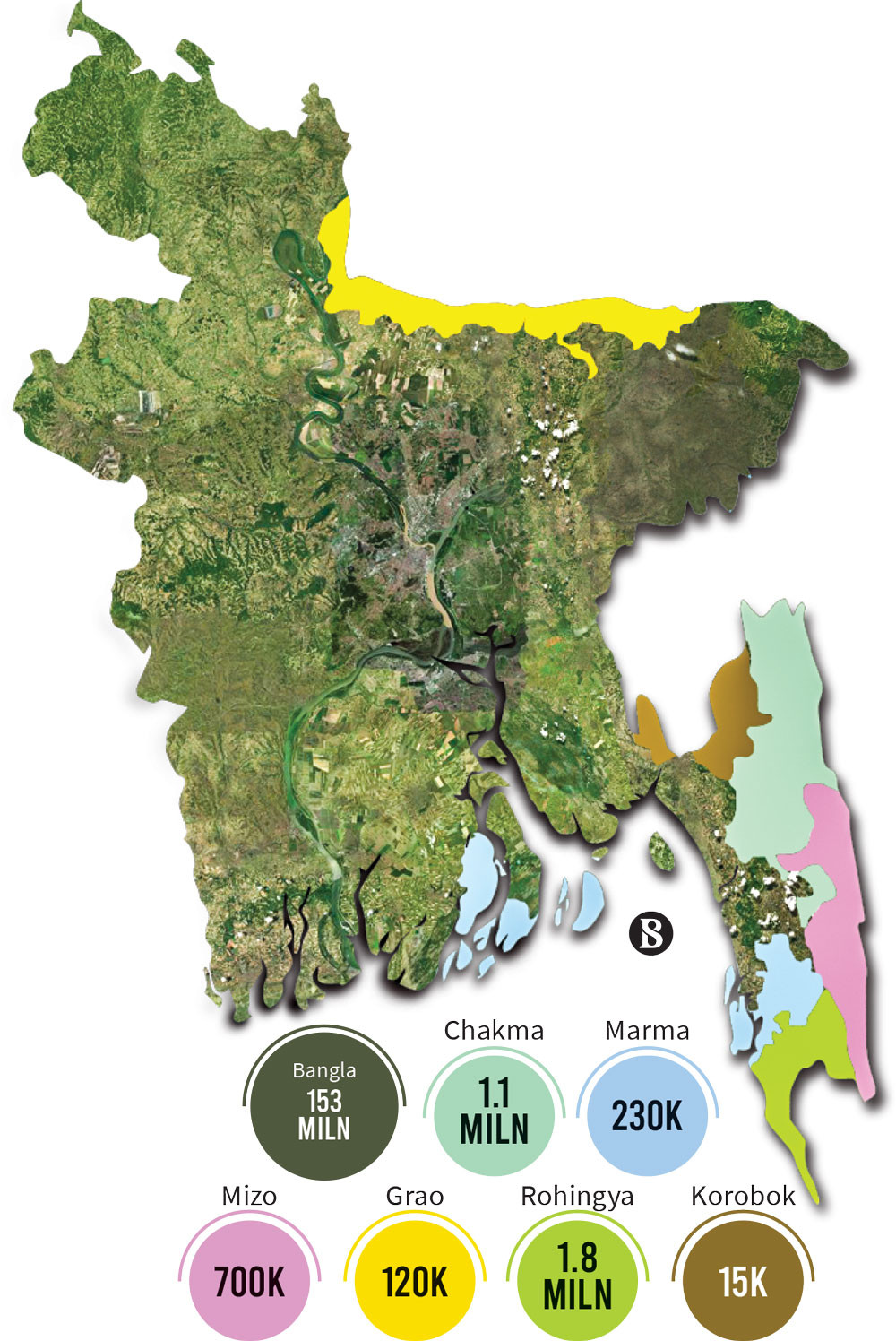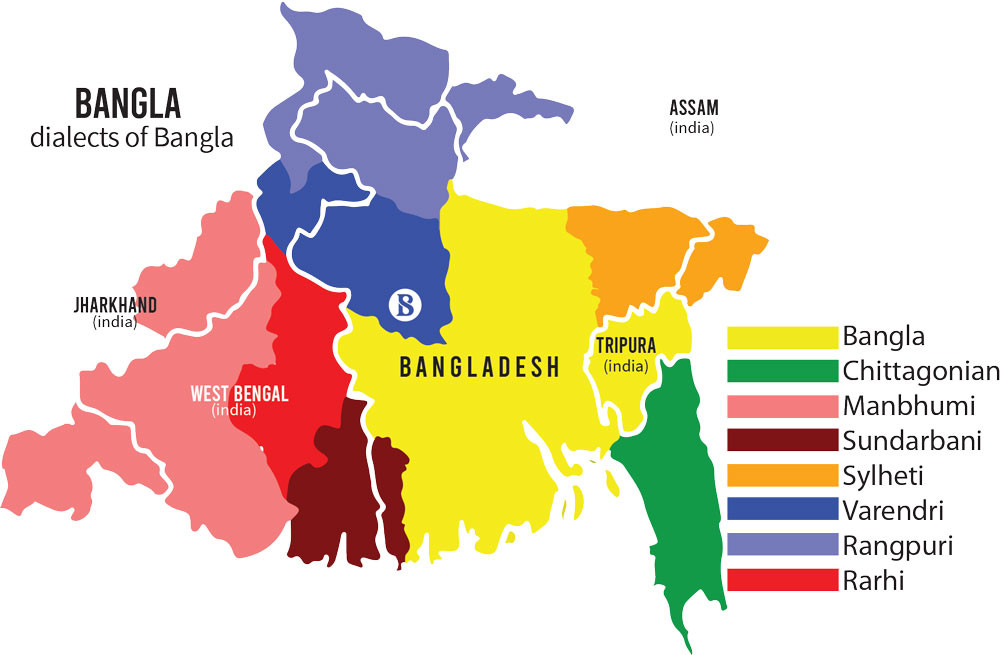Languages of Bangladesh
The number of established languages listed for Bangladesh is 42. Of these, 36 are ethnic minority languages and 6 are non ehtnic minority languages

The number of established languages listed for Bangladesh is 42. All are living languages. Of these, 36 are ethnic minority languages and 6 are non ehtnic minority languages.
Furthermore, 4 are institutional, 13 are developing, 14 are vigorous, and 11 are in trouble. Also listed are 2 unestablished languages.
There are currently 50 ethnic communities enlisted by the Ministry of Cultural Affairs. But unofficially that number there is an estimated 54 communities.
Measures have been taken to include teachers from ethnic groups and texts in ethnic languages at the pre-primary school.
The government has distributed books for the nursery school in five ethnic languages, namely Chakma, Garo, Kokborok, Marma and Sadri.
Bangla
The 3rd article of the Constitution of Bangladesh states Bengali to be the sole official language of Bangladesh. Bengali Language Implementation Act, 1987 made it mandatory to use Bengali in all government affairs except in the cases of foreign relations
According to a 2011 census, Bengali is predominantly spoken by 98% of the country's population and it also serves as the national language of the nation.
The indigenous people of northern and southeastern Bangladesh speak a variety of native languages.
With approximately 228 million native speakers and another 37 million as second language speakers, Bengali is the fifth most-spoken native language and the sixth most spoken language by total number of speakers in the world.
Bengali is the official and national language of Bangladesh, with 98% of Bangladeshis using Bengali as their first language.
Within India, Bengali is the official language of the states of West Bengal, Tripura and the Barak Valley region of the state of Assam.
It is the most widely spoken language in the Andaman and Nicobar Islands in the Bay of Bengal, and is spoken by significant populations in other states including Bihar, Arunachal Pradesh, Delhi, Chhattisgarh, Jharkhand, Meghalaya, Mizoram, Nagaland and Uttarakhand.
Bengali is also spoken by the Bengali diasporas (Bangladeshi diaspora and Indian Bengalis) in Europe, the United States, the Middle East and other countries.
Ethnic minority languages of Bangladesh
There are currently 50 indigenous communities enlisted by the Ministry of Cultural Affairs. But unofficially that number there is an estimated 54 communities. The Indigenous Peoples of Bangladesh speak at least 36 languages.
Measures have been taken to include teachers from Indigenous groups and texts in Indigenous languages at the pre-primary school.
The government has distributed books for the nursery school in five Indigenous languages, namely Chakma, Garo, Kokborok, Marma and Sadri.
Chakma:
Chakma language is an Indo-Aryan language spoken by the Chakma and Daingnet people.
The language has common features with other languages in the region like the Chittagonian, Tanchangya, Arakanese and others.
It is spoken by nearly 320,000 people in southeast Bangladesh in Chittagong Hill Tracts, and another 230,000 in India, including 96,972 in Mizoram, Tripura and Arunachal Pradesh.
It is written using the Chakma script, which is also called Ajhā Pāṭh, sometimes romanised Ojhopath. Literacy in Chakma script is low.
Language family: Indo-European
Bishnupriya Manipuri:
An Indo-Aryan language by the Bishnupriya Manipuri people who live in Bangladesh. Bishnupriya Manipuri is distinct from the Bengali languages and contains many features and elements of the Tibeto–Burman languages.
The Manipuri Bishnupriya or Bishnupriya Manipuri is an Indo-Aryan language spoken in parts of the Indian states of Manipur, Assam, Tripura and others, as well as in the Sylhet Division of Bangladesh, Burma, and other countries. It uses the Bengali script as its writing system.
The orthodox Bishnupriyas claim that they have their own script, that is, the Devanagari script, which was used to write in the Bishnupriya language in its early years.
However, on introduction of modern education during the British period through the Bengali language the Bishnupriya Manipuri writers began to use the Bengali–Assamese script.
79,600 in India (2011 census). Total users in all countries: 119,600.

Santali:
Santali , also known as Santal, is the most widely spoken language of the Munda subfamily of the Austroasiatic languages, related to Ho and Mundari, spoken mainly in the Indian states of Assam, Bihar, Jharkhand, Mizoram, Odisha, Tripura and West Bengal.
It is a recognised regional language of India per the Eighth Schedule of the Indian Constitution. It is spoken by around 7.6 million people in India, Bangladesh, Bhutan and Nepal, making it the third most-spoken Austroasiatic language after Vietnamese and Khmer.
Santali was a mainly oral language until the development of Ol Chiki by Pandit Raghunath Murmu in 1925. Ol Chiki is alphabetic, sharing none of the syllabic properties of the other Indic scripts, and is now widely used to write Santali in India.
Native speakers: 7.6 million (2011 census); Language family:Austroasiatic
Khasi:
Khasi (Ka Ktien Khasi) is an Austroasiatic language spoken primarily in Meghalaya state in India by the Khasi people. It is also spoken by a sizable population in Bangladesh and Assam.
Although most of the 1.6 million Khasi speakers are found in Meghalaya, the language is also spoken by a number of people in the hill districts of Assam bordering with Meghalaya and by a sizable population of people living in Bangladesh, close to the Indian border.
Khasi has been an associate official language of some districts within Meghalaya since 2005, and as of May 2012, was no longer considered endangered by UNESCO.
Khasi is written using the Latin and Bengali-Assamese scripts. Both scripts are taught as part of the compulsory Khasi language subject in elementary up to high school in Meghalaya and Bangladesh respectively.
Garo:
Garo, also referred to by its endonym A·chikku, is a Sino-Tibetan language spoken in India in the Garo Hills districts of Meghalaya, some parts of Assam, and in small pockets in Tripura. It is also spoken in certain areas of the neighbouring Bangladesh. According to the 2011 census, there are about 889,000 Garo speakers in India alone; another 130,000 are found in Bangladesh.
Marma:
There are currently about 3,50,00 Marma people in Bangladesh. Marma is
a member of the Lolo-Burmese branch of the TibetoBurman language family. It is spoken by about 180,600 people in the Chittagong Hill Tracts of Bangladesh, particularly in Rangamati, Bandarban and Khagrachari districts. It is considered one of the dialects of Arakanese, along with Ramree and Sandowa.
Mro /Mru:
Mru is also known as Mrung (Murung) that is a Sino-Tibetan language as well as called a recognized language of Bangladesh. It is spoken by a community of Mros (Mrus) inhabiting the Chittagong Hill Tracts of Bangladesh with a
population of 22,000 according to the 1991 census.
Major Dialects of Bengali

Chittagonian: Spoken by Chittagonians in the Southeastern districts of Chittagong, Cox's Bazar and also in the Chittagong Hill Tracts. User Population: 13,000,000
Used as an L2 (provincial) in Rangamati, Bandarban, Cox' s Bazar, and Chittagong districts primarily for business and market. According to the status of Top 100 Languages by Population by Ethnologue, Chittagong ranked 67th of the world.
Not inherently intelligible with Bengali, although considered a nonstandard Bengali dialect. Dialects form a continuum from north to south, with a larger religious distinction between Muslim and others. Rohingya [rhg] in Myanmar is reportedly similar to the southern dialect of Chittagonian. Lexical similarity: 43%–64% with Bangla.
Essentially, Chittagonian has no standard form and is rather a continuum of different dialects, varying with location from north to south and also by religion between Muslims (professed by most Chittagonians) and Hindus. Variation between Muslims and Hindus is strictly in terms of vocabulary, whereas by location, grammar is varied as well as vocabulary.
Sylheti: Sylheti is an Indo-Aryan language spoken by an estimated 11 million people, primarily in the Sylhet Division of Bangladesh, the Barak Valley and Hojai district of Assam, and North Tripura and Unakoti district of Tripura, India.
Besides, there are substantial numbers of Sylheti speakers in the Indian states of Meghalaya, Manipur and Nagaland as well as diaspora communities in the United Kingdom, the United States, and the Middle East.
It is variously perceived as either a dialect of Bengali or a language in its own right. While most linguists consider it an independent language, for many native speakers Sylheti forms the diglossic vernacular, with standard Bengali forming the codified lect.
Some incorrectly consider it as a "corrupt" form of Bengali, and there is a reported language shift from Sylheti to Standard Bengali in Bangladesh, India and the diaspora; though Sylheti has more vitality than Standard Bengali in the United Kingdom.
Reportedly similar to Assamese. Lexical similarity: 70% with Bengali. Native speakers are around 10 million, with 1.5 million people's second language. Sylheti has a relatively large set of loanwords from Arabic, Hindi and Persian. The Sylheti language is written in the Sylheti Nagri script. Sylhet has a rich heritage of literature in the Sylheti Nagri script going back at least 200 years.
Dhakaiya Kutti: Dhakaiya Kutti, also known as Old Dhakaiya or simply Dhakaiya, is a Bengali dialect, spoken by the original Dhakaiyas of Old Dhaka in Bangladesh.
This language is largely intelligible with Standard Bengali but has some differences in vocabulary.
Usage of the dialect is in decline as many families are opting to raise their children to speak Standard Bengali due to it being the official medium in the country and the influence of Dhaka city as the capital.
Noakhailla: Spoken by the Noakhaillas in the Eastern districts of Noakhali, Feni and Lakshmipur as well as some areas in Greater Comilla and southern Chittagong
Noakhailla, also known as Noakhalian, is an Indo-Aryan language, spoken by an estimated 7 million people, primarily in the Greater Noakhali region of Bangladesh as well as southern parts of Tripura in India.
Outside of these regions, there are substantial numbers of Noakhailla speakers in other parts of Bangladesh; as well as diaspora communities in the Middle East, Italy, Europe and the United States.
Though often considered a Bengali dialect, some have labelled it as undecipherable to speakers of Standard Bengali and that it has a "vague" relationship with it.
Noakhailla has no presence in formal settings, neither in Bangladesh nor India, though its standardisation has been prospected.
Rongpuri: Rangpuri is an eastern Indo-Aryan language of the Bengali-Assamese branch, spoken by the people of northern West Bengal, western Goalpara of Assam in India and Rangpur Division in Bangladesh.
Many are bilingual in Bengali and Assamese in their respective regions. According to Glottolog, it forms the Central-Eastern Kamta group with the Kamta language. Together with Rajbanshi and Surjapuri they form the Kamta group of languages.
It is spoken by the people in Rajshahi division: Joypurhat area; Rangpur division: Dinajpur, Gaibandha, Lalmonirhat, Nilphamari, Panchagarh, Rangpur, and Thakurgaon districts. Native speakers are around 15 million



 Keep updated, follow The Business Standard's Google news channel
Keep updated, follow The Business Standard's Google news channel
















